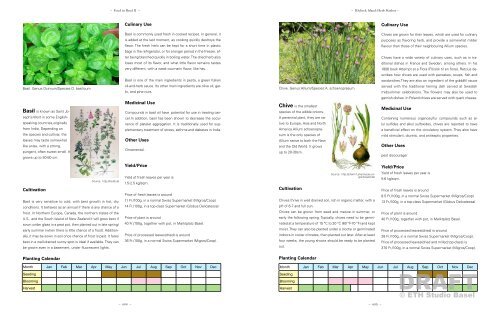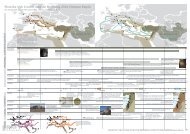BASEL-STADT: 4 PRoPoSALS - ETH Basel
BASEL-STADT: 4 PRoPoSALS - ETH Basel
BASEL-STADT: 4 PRoPoSALS - ETH Basel
You also want an ePaper? Increase the reach of your titles
YUMPU automatically turns print PDFs into web optimized ePapers that Google loves.
Basil. Genus:Ocimum/Species:O. basilicum<br />
Basil is known as Saint Joseph’s<br />
Wort in some Englishspeaking<br />
countries,originally<br />
from India. Depending on<br />
the species and cultivar, the<br />
leaves may taste somewhat<br />
like anise, with a strong,<br />
pungent, often sweet smell. It<br />
grows up to 50-80 cm.<br />
Cultivation<br />
Source: http://biolib.de<br />
Basil is very sensitive to cold, with best growth in hot, dry<br />
conditions. It behaves as an annual if there is any chance of a<br />
frost. In Northern Europe, Canada, the northern states of the<br />
U.S., and the South Island of New Zealand it will grow best if<br />
sown under glass in a peat pot, then planted out in late spring/<br />
early summer (when there is little chance of a frost). Additionally,<br />
it may be sown in soil once chance of frost is past. It fares<br />
best in a well-drained sunny spot.is ideal if available. They can<br />
be grown even in a basement, under fluorescent lights.<br />
Planting Calendar<br />
– Food in <strong>Basel</strong> II – – Klybeck Island: Herb Harbor –<br />
Culinary Use<br />
Basil is commonly used fresh in cooked recipes. In general, it<br />
is added at the last moment, as cooking quickly destroys the<br />
flavor. The fresh herb can be kept for a short time in plastic<br />
bags in the refrigerator, or for a longer period in the freezer, after<br />
being blanched quickly in boiling water. The dried herb also<br />
loses most of its flavor, and what little flavor remains tastes<br />
very different, with a weak coumarin flavor, like hay.<br />
Basil is one of the main ingredients in pesto, a green Italian<br />
oil-and-herb sauce. Its other main ingredients are olive oil, garlic,<br />
and pine nuts.<br />
Month Jan Feb Mar Apr May Jun Jul Aug Sep Oct Nov Dec<br />
Seeding<br />
Blooming<br />
Harvest<br />
Medicinal Use<br />
Compounds in basil oil have potential for use in treating cancer.In<br />
addition, basil has been shown to decrease the occurrence<br />
of platelet aggregation. It is traditionally used for supplementary<br />
treatment of stress, asthma and diabetes in India.<br />
Other Uses<br />
Ornamental.<br />
Yield/Price<br />
Yield of fresh leaves per year is<br />
1.5-2.5 kg/sqm.<br />
Price of fresh leaves is around<br />
11 Fr./100g, in a normal Swiss Supermarket (Migros/Coop)<br />
14 Fr./100g, in a top-class Supermarket (Globus Delicatessa)<br />
Price of plant is around<br />
40 Fr./100g, together with pot, in Marktplatz <strong>Basel</strong>.<br />
Price of processed leaves(dried) is around<br />
36 Fr./100g, in a normal Swiss Supermarket (Migros/Coop).<br />
Chive. Genus:Allium/Species:A. schoenoprasum<br />
Chive is the smallest<br />
species of the edible onions.<br />
A perennial plant, they are native<br />
to Europe, Asia and North<br />
America.Allium schoenoprasum<br />
is the only species of<br />
Allium native to both the New<br />
and the Old World. It grows<br />
up to 20-30cm.<br />
Cultivation<br />
Chives thrive in well drained soil, rich in organic matter, with a<br />
pH of 6-7 and full sun.<br />
Chives can be grown from seed and mature in summer, or<br />
early the following spring. Typically, chives need to be germinated<br />
at a temperature of 15 °C to 20 °C (60 °F-70 °F) and kept<br />
moist. They can also be planted under a cloche or germinated<br />
indoors in cooler climates, then planted out later. After at least<br />
four weeks, the young shoots should be ready to be planted<br />
out.<br />
Planting Calendar<br />
Month Jan Feb Mar Apr May Jun Jul Aug Sep Oct Nov Dec<br />
– 604 – – 605 –<br />
Seeding<br />
Blooming<br />
Harvest<br />
Source: http://pharm1.pharmazie.unigreifswald.de/<br />
Culinary Use<br />
Chives are grown for their leaves, which are used for culinary<br />
purposes as flavoring herb, and provide a somewhat milder<br />
flavour than those of their neighbouring Allium species.<br />
Chives have a wide variety of culinary uses, such as in traditional<br />
dishes in France and Sweden, among others. In his<br />
1806 book Attempt at a Flora (Försök til en flora), Retzius describes<br />
how chives are used with pancakes, soups, fish and<br />
sandwiches.They are also an ingredient of the gräddfil sauce<br />
served with the traditional herring dish served at Swedish<br />
midsummer celebrations. The flowers may also be used to<br />
garnish dishes. In Poland chives are served with quark cheese.<br />
Medicinal Use<br />
Containing numerous organosulfur compounds such as allyl<br />
sulfides and alkyl sulfoxides, chives are reported to have<br />
a beneficial effect on the circulatory system. They also have<br />
mild stimulant, diuretic, and antiseptic properties.<br />
Other Uses<br />
pest discourager<br />
Yield/Price<br />
Yield of fresh leaves per year is<br />
5-6 kg/sqm.<br />
Price of fresh leaves is around<br />
8.5 Fr./100g, in a normal Swiss Supermarket (Migros/Coop)<br />
13 Fr./100g, in a top-class Supermarket (Globus Delicatessa)<br />
Price of plant is around<br />
40 Fr./100g, together with pot, in Marktplatz <strong>Basel</strong>.<br />
Price of processed leaves(dried) is around<br />
28 Fr./100g, in a normal Swiss Supermarket (Migros/Coop).<br />
Price of processed leaves(dried and milled,top-class) is<br />
370 Fr./100g, in a normal Swiss Supermarket (Migros/Coop).<br />
DRAFT<br />
© <strong>ETH</strong> Studio <strong>Basel</strong>













